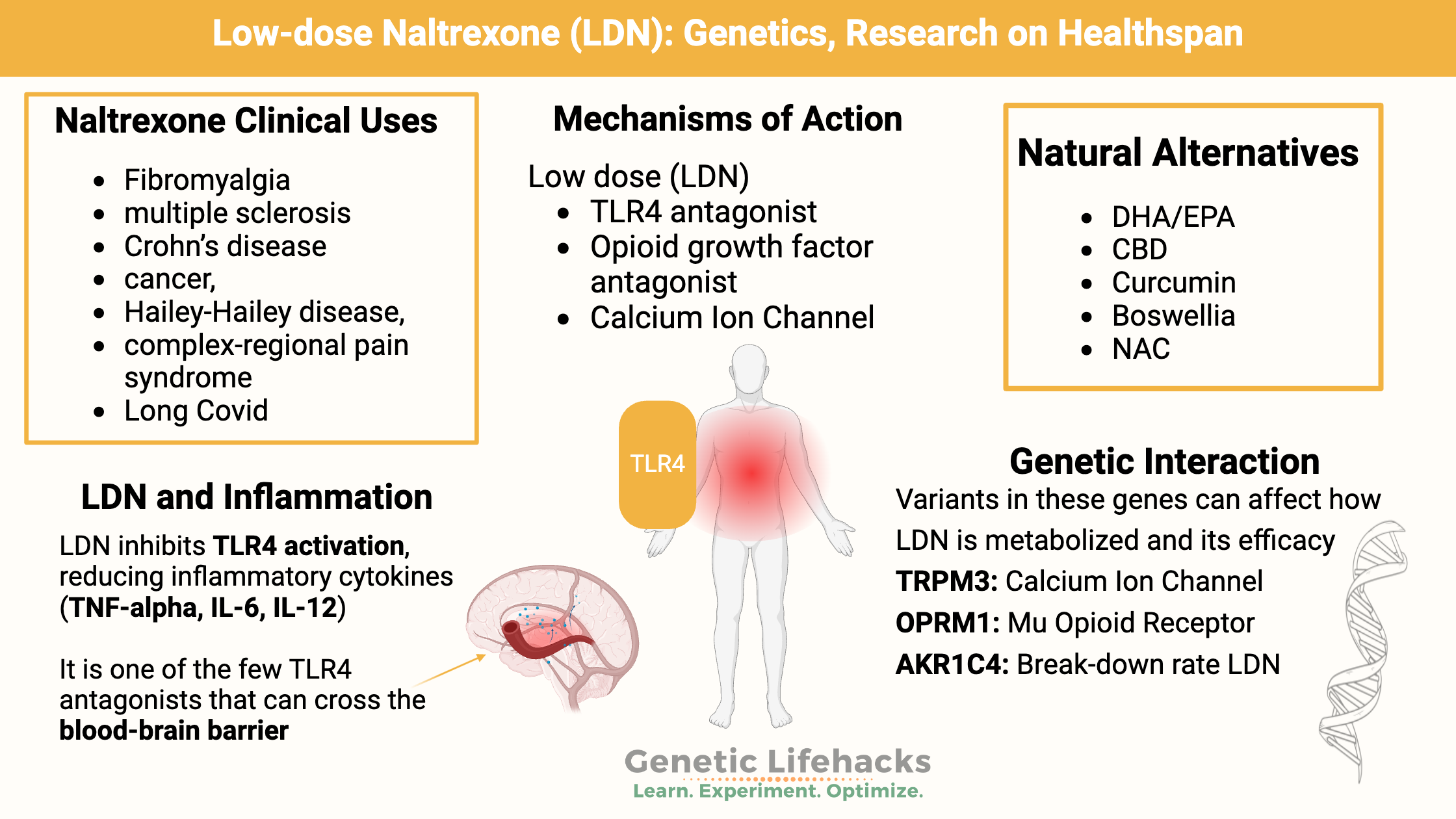Low-Dose Naltrexone (LDN)

Low-Dose Naltrexone (LDN)
Low-dose naltrexone (LDN) refers to the administration of naltrexone at doses approximately one-tenth of the standard dose used for opioid addiction treatment, typically around 4.5 mg daily. Unlike standard doses that produce sustained opioid receptor blockade, LDN transiently blocks opioid receptors, leading to a paradoxical upregulation of the endogenous opioid system and modulation of immune responses.
Mechanism of Action
- Transient Opioid Receptor Blockade and Rebound Effect:
At low doses, naltrexone briefly blocks μ-opioid, δ-opioid, and κ-opioid receptors for a few hours. This transient blockade prompts the body to increase production of endogenous opioids (endorphins, met-enkephalins, also called opioid growth factors) and upregulate opioid receptor expression, enhancing natural opioid signaling and analgesia135. - Neuroimmune Modulation via Toll-Like Receptor 4 (TLR4):
LDN antagonizes TLR4 receptors on microglia and macrophages in the central nervous system. Activated microglia produce pro-inflammatory cytokines and neurotoxic substances contributing to pain, fatigue, cognitive dysfunction, and mood disorders. By inhibiting TLR4, LDN reduces microglial activation and suppresses the inflammatory cascade, exerting anti-inflammatory and neuroprotective effects2467. - Bimodal Cellular Opioid Response:
Opioids induce both inhibitory Gi-coupled and stimulatory Gs-coupled receptor responses. LDN’s modulation of these pathways may reduce hyperalgesia, tolerance, and dependence associated with chronic opioid receptor stimulation1. - These mechanisms are not mutually exclusive and likely act synergistically to produce LDN’s therapeutic effects.
Therapeutic Uses
LDN has been studied in various chronic conditions involving immune dysregulation and chronic pain, including:
- Fibromyalgia
- Multiple sclerosis
- Crohn’s disease
- Complex regional pain syndrome
- Autoimmune diseases
- Chronic fatigue syndrome
While it remains off-label due to limited large-scale clinical trials, LDN shows promise as a low-cost, well-tolerated immunomodulatory and analgesic agent346.
Summary Table
| Aspect | Details |
|---|---|
| Typical Dose | ~4.5 mg daily (about one-tenth of standard naltrexone dose) |
| Primary Mechanisms | Transient opioid receptor blockade → endogenous opioid upregulation; TLR4 antagonism → reduced microglial activation |
| Effects | Enhanced endogenous analgesia, anti-inflammatory, neuroprotective |
| Conditions Studied | Fibromyalgia, multiple sclerosis, Crohn’s disease, chronic pain syndromes, autoimmune disorders |
| Safety Profile | Generally well tolerated; fewer side effects than standard-dose naltrexone |
Consult with Our Team of Experts Now!
At DrStemCellsThailand (DRSCT)‘s Anti-Aging and Regenerative Medicine Center of Thailand, we emphasize comprehensive evaluations and personalized treatment plans of Cellular Therapy and Stem Cells for managing various health conditions. If you have questions about Low-Dose Naltrexone (LDN) or would like more information on our services, consult with our experts today!
Consult with Our Team of Experts Now!
References
- Smith JP, Stock H, Bingaman S, Mauger D, Rogosnitzky M, Zagon IS. Low-Dose Naltrexone Therapy Improves Active Crohn’s Disease. Am J Gastroenterol. 2011;106(2):203-210.
https://doi.org/10.1038/ajg.2010.392
PMC Article - Younger J, Mackey S. Fibromyalgia symptoms are reduced by low-dose naltrexone: a pilot study. Pain Med. 2009;10(4):663-672.
https://doi.org/10.1111/j.1526-4637.2009.00613.x - Low Dose Naltrexone Research Trust. How Low Dose Naltrexone Works.
https://ldnresearchtrust.org/how-low-dose-naltrexone-works - Hutchinson MR, Zhang Y, Shridhar M, et al. Non-stereoselective reversal of neuropathic pain by naloxone and naltrexone: involvement of toll-like receptor 4 (TLR4). J Neurosci. 2008;28(45):11126-11134.
https://doi.org/10.1523/JNEUROSCI.2607-08.2008
PMC Article - Bihari B. Low-dose naltrexone and HIV infection. Med Hypotheses. 1995;44(4):319-322.
https://doi.org/10.1016/0306-9877(95)90109-7 - Pflüger M, Oberländer K. The Science Behind Low Dose Naltrexone. ID Doctor Dublin. 2017.
https://doi.org/10.13140/RG.2.2.11174.48965 - Barr L. How Low Dose Naltrexone Helps Treat Autoimmunity. 2023.
https://barrcenter.com/how-low-dose-naltrexone-works-in-autoimmunity/
Low-dose naltrexone represents a novel therapeutic approach that modulates the endogenous opioid system and neuroimmune interactions, offering potential benefits in various chronic inflammatory and pain conditions.















